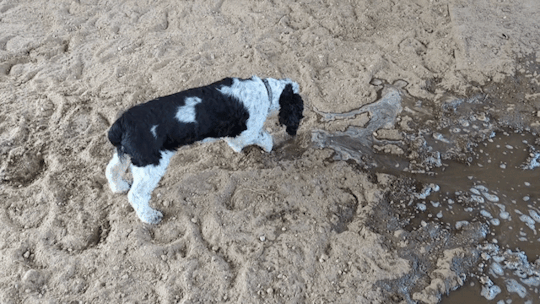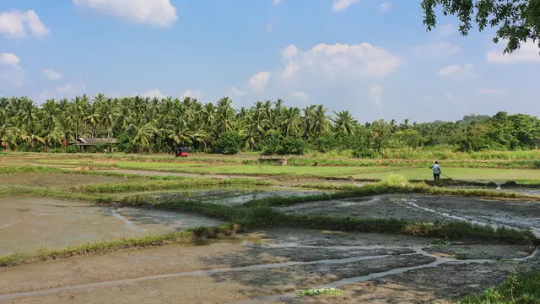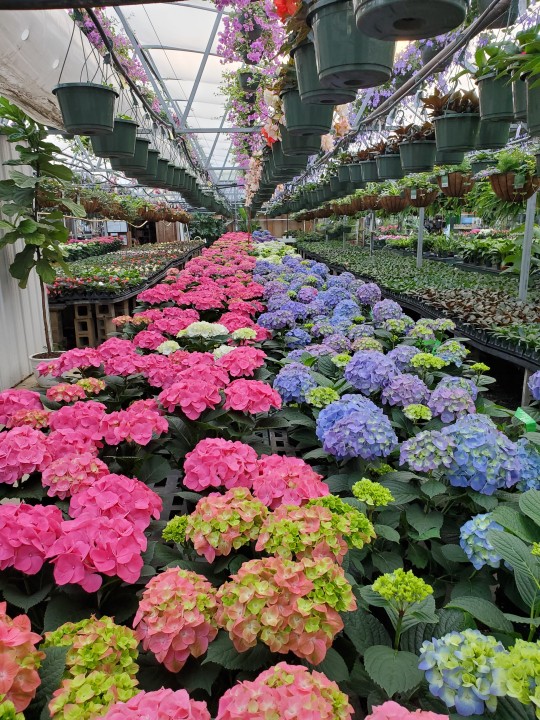#in in irrigation
Text
I really hope they can work the bugs out of this solution, because if it's done right, it'll really be a win-win situation. Less evaporation of water, and solar power being generated every day? Yes, please. We are smart, resourceful beings, and this is far from the most difficult problem we've had to address.
This is also a great example of how we can go back and fix mistakes of the past. We very, very rarely ever come up with technological solutions that take long-term effects on the environment into consideration, and so the way many things are designed often leads to some sort of damage, whether through manufacture, use, disposal, or all of the above. Retrofitting canals (which have been used in agriculture for thousands of years) will have benefits not only in the ways mentioned above, but also gets people thinking more about the impacts we make.
I'm hoping that this will lead to more new technology being developed in ways that already anticipate and account for negative impacts so that they avoid them in the first place, rather than having to engineer new solution many years down the line.
#solar power#solar panels#renewable energy#water#environment#irrigation#agriculture#green energy#conservation#technology#clean energy#science#solarpunk#hopepunk
686 notes
·
View notes
Text
ART, visibly on the edge of a meltdown because SecUnit replied to a message from Holism with "k": i'm going to puke stop talking to Holism i swear to god. baby you're everything to me please please don't fuck Holism
#murderbot#system collapse spoilers#murderhelion#i've not yet begun to be obnoxious about this btw#i'm making a mountain out of this molehill#of course it's trying to seduce SecUnit; it's talking about civil engineering!#the relief ART must feel when SecUnit foists Three onto Holism instead#suck it Holism SecUnit's a jock it cares not for your intellectual temptations#go design an irrigation system or a bridge or something and die about it
247 notes
·
View notes
Text

Acequia , Irrigation ditch - Carlos Morago
Spanish,b.1954-
Oil on wood, 30 x 30 cm.
326 notes
·
View notes
Text





4x02 | Infected
#v necessary#Rick Grimes#*#rg#S4#a+ fanservice#i had to google who wrote this episode lol thanks angela#it was nice when on the rare occasion it was showcased that you know man is hot#sorry you were having a really bad day tho babe#H A N D S#FARMER DADDY#excuse me but the nose™#*dramatically takes off and burns shirt*#it'sart.gif#THAT ARM VEIN THO#irrigate my crops farmer rick#also his arm hair but i'm not gonna be that weird right now#even his armp- nevermind#........just drink your wine#me @ me: 🔇#happy sinday 💚
218 notes
·
View notes
Text
Water scarcity and the high cost of energy represent the main problems for irrigation communities, which manage water for this end, making it available to agriculture.
In a context of drought, with a deregulated and changing electricity market, knowing when and how much water crops are going to be irrigated with would allow those who manage them to overcome uncertainty when making decisions and, therefore, guide them towards objectives like economic savings, environmental sustainability, and efficiency. For this, data science and Artificial Intelligence are important resources.
Continue Reading.
72 notes
·
View notes
Text
Archaeologists have uncovered a sophisticated piece of civil engineering in China- a ceramic water drainage system dating back 4,200 years, still intact!
186 notes
·
View notes
Text
Today we are learning Civil Engineering! We are exploring canals and irrigation.
Afterwards we went through the wading pool a few times and then dumped it. That's some fine, dusty sand, and it makes sticky sloppy mud. Good day for it, though, still under heatwave conditions.
[Video Description: Tristan, a black and white cocker spaniel, splashes in water at the edge of a puddle. As he splashes, he digs out the edges of the puddle, and water flows toward him in new rivulets. The first time he jumps backwards as the water rushes towards him, but afterwards he lets it run--has he done this before, with a bigger puddle? Sounds: splashing in water, and behind us, horses banging buckets as they eat.]

Good grief he's adorable 😄
#tristan#cocker spaniel#dogblr#the professor#expanding his interests beyond geology#wet beast wednesday#video#clever boy#gif#the laughter is gonna kill me#emergency bath#a muddy dog is a happy dog#civil engineering canals and irrigation#a dam smart boy
147 notes
·
View notes
Text

Puquios
594 notes
·
View notes
Text
Some of the world’s largest investment banks, pension funds and insurers, including Manulife Financial Corp.’s John Hancock unit, TIAA and UBS, have been depleting California’s groundwater to grow high-value nuts, leaving less drinking water for the surrounding communities, according to a Bloomberg Green investigation. Wall Street has come to Woodville, wringing it dry. Since 2010, six major investors have quadrupled their farmland under management in California, to almost 120,000 acres in all, equivalent to a third of all the cropland in Connecticut.
[...]
This rush for water is an outgrowth of a decades-long bet on farmland by investors who see food cultivation as an asset class virtually assured of appreciating in a warming, more populous world. Globally, large investors and agribusinesses have snapped up about 163 million acres of farmland in more than 100 countries in the past 20 years. The land grab has given rise to a grab of an even scarcer global commodity: water. In a bid to ensure thriving investment portfolios, some of the world’s largest financial entities have amassed control over lakes, rivers and underground aquifers in places from California to Africa, Australia to South America, giving them outsize roles in managing an endangered resource that’s the basis of life on Earth. The trend has contributed to shifting hydrological patterns that stand to permanently disrupt communities’ access to fresh water. Local populations are paying the price in drained wells, high water bills and contaminated water supplies.
[...]
In the past decade, parts of the San Joaquin Valley have dropped as much as a foot per year, according to the US Geological Survey. Subsidence, as the sinking is called, has damaged bridges, canals and other infrastructure that will cost billions of dollars to fix, the state says. The aquifers themselves are irreparable. Many groundwater basins, when drained, never recover their former storage capacity, hydrologists have found. “Groundwater in California has been treated as an extractive resource—you pump and hope for the best,” says Graham Fogg, an emeritus professor of hydrology at the University of California at Davis. “Capitalism is driving this. Investors don’t care, because in 10 years they can make all the money they want and leave.”
85 notes
·
View notes
Text

#own photo#found this today#a sort of well... thing?#maybe for irrigation#or mining#there were two of them#I'll post up some more#I just wanted this one on it's own#lensblr#original photography
34 notes
·
View notes
Text
A 2,000-year-old Sri Lankan hydraulic system uses natural features to help harvest and store rainwater. In a rapidly warming world, it is providing a lifeline for rural communities.
Each April, in the village of Maeliya in northwest Sri Lanka, Pinchal Weldurelage Siriwardene gathers his community under the shade of a large banyan tree. The tree overlooks a human-made body of water called a wewa – meaning reservoir or "tank" in Sinhala. The wewa stretches out besides the village's rice paddies for 175-acres (708,200 sq m) and is filled with the rainwater of preceding months.
Tank cascades are receiving new attention as climate change is projected to increase both Sri Lanka's drought and flood risk (Credit: Zinara Rathnayake)

Siriwardene, the 76-year-old secretary of the village's agrarian committee, has a tightly-guarded ritual to perform. By boiling coconut milk on an open hearth beside the tank, he will seek blessings for a prosperous harvest from the deities residing in the tree. "It's only after that we open the sluice gate to water the rice fields," he told me when I visited on a scorching mid-April afternoon.
By releasing water into irrigation canals below, the tank supports the rice crop during the dry months before the rains arrive. For nearly two millennia, lake-like water bodies such as this have helped generations of farmers cultivate their fields. An old Sinhala phrase, "wewai dagabai gamai pansalai", even reflects the technology's centrality to village life; meaning "tank, pagoda, village and temple".
But the village's tank does not work alone. It is part of an ancient hydraulic network called an ellangawa, or "tank cascade system". As such, the artificial lake at Maeliya links up with smaller, man-made reservoirs upstream in the watershed. Together with their carefully managed natural surroundings, these interconnecting storage structures allow rainwater to be harvested, shared and re-used across the local area.

Constructed from the 4th Century BC up to the 1200s, these cascade systems have long helped Sri Lankan communities cope with prolonged periods of dry weather. "As most of the country is made up of crystalline hard rock with poor permeability, it induces runoff, " says Christina Shanthi De Silva, senior professor in agricultural and plantation engineering at The Open University of Sri Lanka. "Our forefathers built tank cascades to capture this surface runoff," she explains, preventing it from being washed away into rivers and, ultimately, the sea.
Such knowledge has since been passed down the generations. In a laminated box file, Siriwardene carefully safeguards a map his father, the village head, drew of Maeliya's cascade. There are nine tanks in this particular cascade, his father writes. A copy of another handwritten booklet documents the tanks' history and the folk poems that villagers sang in gratitude for its continuous water resource.
#solarpunk#solar punk#jua kali solarpunk#indigenous knowledge#community#informal economy#sri lanka#irrigation#cascades
18 notes
·
View notes
Text
I spent approx. 2.5 hours cleaning the house nonstop
#been raining since dawn!!!#and my house flooded like literally flooded#bcs apparently the waterways?? irrigation??drain?? in my backyard was clogged with fallen leaves and branches#so water came into my house lol literal puddles#my sensitive skin didn’t appreciate it lol I’m itching!!#I want to sleep until the weekend
13 notes
·
View notes
Text
Eddie: *lying on the floor* I am field.
Buck: Explain?
Eddie: Need to be plowed.
Buck: *already taking his pants off* Eddie, I thought I told you I'd always have your back.
#incorrect 911 quotes#incorrect buddie#buddie#911#911 abc#evan buckley#eddie diaz#the firehose is real#bottom!eddie#top!buck#gonna irrigate that field just right#hen wilson#chimney han#bobby nash#ravi panikkar
114 notes
·
View notes
Note
Trick or Treat!
youtube
AH Hello, my future victim What are you doing in my inbox? it seems that you have stumbled across into my den of horrors. Before I drag you into the depths of below, check out this video I saved in my hk playlist and LOOK YOU GOTTA SEE THIS
#I BEG YOU TO CHECK OUT THIS ANIMATION#this is one of my favorite hk artworks so far and this is a legit masterpiece i had in my playlist#I am 100% normal about this video#YEAh totally 👍👍#definitely not thinking about another nosk idea again yeah i promise#BUT THE ANIMATION AND THE CONCEPT SO COOL#I WISH SOMEONE HAD WRITTEN A FANFIC ABOUT THIS BECAUSE I JUST LOVE THE IDEA#not my art#ask#trick or treat ask#BUT SERIOUSLY I AM IRRIGATED BY THIS IDEA AND ITS GIVING ME BRAIN WORMS#everyone needs to see this#nosk#one of my fav videos in yt#hornet#quirrel#hk ghost#hk knight#PLEASE WATCH THIS PLS PLS#hollow knight#hollow knight art
25 notes
·
View notes
Text
youtube
Permaculture instructor Andrew Millison journeys to South India to film the ancient water management system of the Cholla Dynasty in the Cauvery River Delta. We visit multiple structures within the state of Tamil Nadu including the Kallanai Dam, the Ranganathaswamy Temple, and numerous smaller check dams which split the Cauvery River into a vast delta which is the rice-basket of South India. This ancient design when seen as a whole actually creates the largest inland water body in the entire country of India.
Digital Map Animation:
https://www.pearlriverecodesign.com/
Shubo Biswas of GreenGood Labs:
https://www.greengoodlabs.com/
Steve Borgia's absolutely epic hotel in the Cauvery Delta:
https://indecohotels.com/indeco-swami...
Post Production by Meenarts.com
Drone Credits: Gopinath, @cymatics.in.
#Andrew Millison#solarpunk#permaculture#india#water#irrigation#river#Cholla Dynasty#Cauvery River Delta#Cauvery River#Tamil Nadu#Kallanai Dam#Ranganathaswamy Temple#Youtube
25 notes
·
View notes
Text

Every morning, I am annoyed by the lone white hydrangea mixed into the pinks
#greenhouse content#hydrangeas suck go away be gone but also... so pretty#like i hate planting them hate the fuss of growing them#hate worrying about pH and waiting for color to show if i did it wrong#hate fertilizing them hate constantly wetting the greenhouse floor so they cool down#hate timing when i water so i can cool them down with irrigation#hate staking them when they flop#hate hate telling customers again and again that theyre NOT hardy here sorry they don't rebloom#or if they do there are better hardy options later in the season#i'm SO tired of explaining hydrangeas to people zzzz#but they're pretty
54 notes
·
View notes